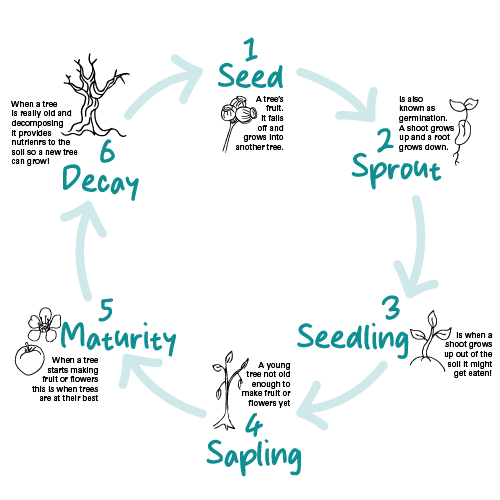The Life Cycle of a Tree
Trees are like all living organisms; they start off small and grow large over a number of years, in a number of clear stages.
Trees like to grow with other trees in a forest, and at all stages of their long life, trees contribute to the envirnment around them.
The following cycle is based on an oak tree and depicts each stage of its life.
- Seed: An acorn is an oak tree’s fruit, created during the tree’s maturity, which is dispersed into the ecosystem to grow into a new tree.
- Sprout: (Germination) When the seed has found the right conditions, the first root breaks through the seed which anchors it to the ground and provides water, and an embryonic shoot emerges, moving up through the soil.
- Seedling: Once the embryonic shoot rises above ground, it becomes a seedling, a vulnerable stage where it’s at risk from diseases and damage from animals.
- Sapling: A tree becomes a sapling when it is over one meter in length (depending on the tree species), and have flexible trunks, smooth bark, and an inability to produce fruit or flowers.
- Maturity: A tree becomes mature when it starts producing fruits or flowers, this is when the tree is most productive. A typical English oak tree produces acorns at around 40 years old and peaking around 80 - 120 years old. Oaks in general can be productive for 300 years. These fruits are dispersed, and the cycle continues.
- Decay: A decaying tree is a tree in its final stages of its life and can topple or remain standing. Despite dying, this stage is when a tree is at its most useful to the ecosystem in the following ways: Dead wood provides homes for insects and fungi, those insects are food sources for birds, bats, and other animals, those creatures use holes and hollows in the trunk for shelter, and those animals become food for larger animals.
Tree Life Cycle
Trees contribute a lot to the ecosystem it grows in but also to the entire world through Photosynthesis. A tree’s leaves absorb carbon dioxide (which is toxic) from the air and water, then uses energy from the sun to convert them into a tree’s food (sugars). This chemical reaction creates oxygen (what living things need) as a by-product, which the tree releases into the air. A single mature oak tree can produce, on average, 100,000L of oxygen a year or 274L a day – nearly half the amount an average human needs in a day!
Trees also contributes to the fight against global warming in three ways:
- Cleaning the air through the absorption of toxic carbon dioxide and converting it into oxygen.
- Creating heat refuges (shade) which lowers the amount of heat energy that the sun bakes into the ground.
- Transpiration – which is the process trees use to absorb hot ground water through its roots, which cools the environment by releasing water vapor into the air through its leaves. Trees can also provide cooling through evaporation of rainfall collecting on leaves and in soil.








